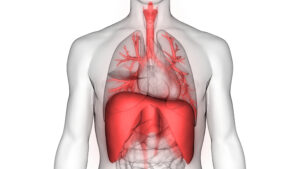Singers are wind instruments. The way we take, use and manage our breath matters a lot when it comes to making beautiful, sustainable sounds in every genre. So, it’s hardly surprising that “breath support” is a hot topic for voice students and singing teachers. But one phrase I hear way too often is “sing from the diaphragm.” It’s a pet peeve if I’m honest. What does that even mean, especially to a new voice student? What is the diaphragm? What does it do? How do we sing from it?
 Well, let’s start with what it is. The DIAPHRAGM is a large, domed muscle that separates the abdomen and the chest. It’s rounded at the top and fits snuggly inside the ribcage just beneath the lungs and heart. The diaphragm is the primary muscle of respiration and thus has a major impact on the quality of our breath. As we inhale the diaphragm contracts and flattens, displacing viscera and pulling open the lower ribs, opening the chest cavity. This creates a vacuum effect and causes the lungs to fill with air. As we exhale, the diaphragm relaxes and retreats to its original resting place, along with the lungs, ribs and viscera. Your diaphragm engages in this little dance hundreds of thousands of times per day. It moves automatically without your knowledge or awareness. In fact, we can’t breathe without it!
Well, let’s start with what it is. The DIAPHRAGM is a large, domed muscle that separates the abdomen and the chest. It’s rounded at the top and fits snuggly inside the ribcage just beneath the lungs and heart. The diaphragm is the primary muscle of respiration and thus has a major impact on the quality of our breath. As we inhale the diaphragm contracts and flattens, displacing viscera and pulling open the lower ribs, opening the chest cavity. This creates a vacuum effect and causes the lungs to fill with air. As we exhale, the diaphragm relaxes and retreats to its original resting place, along with the lungs, ribs and viscera. Your diaphragm engages in this little dance hundreds of thousands of times per day. It moves automatically without your knowledge or awareness. In fact, we can’t breathe without it!
When teachers reference the diaphragm in lessons, they are usually referring to it in the context of breath support. As singers, “breath support” entails slowing down the process of exhalation and regulating breath flow to create an efficient balance between the breath, the vocal folds and the shape of the resonator (throat and mouth). While the diaphragm plays a major role in respiration, it is largely an involuntary muscle…meaning we don’t have a lot of direct control over it. In addition, the process of phonation (making sound) does not rely solely upon the movement of the diaphragm. The mechanisms of phonation (vocal folds, larynx, resonator) are all located in the throat. So, how do we sing from the diaphragm? The answer is, WE CAN’T.
While we cannot control the movement of the diaphragm, we do have the ability to influence its movement through the abdominal muscles. And when students are told to “support,” “sing from” or “engage” the diaphragm, it usually results in a lot of tightness in the abs. Herein lies another problem – when we tighten the abdominals, we restrict the movement of the diaphragm, which makes inhalation and exhalation much, much more difficult.You can discover this for yourself. Tighten your stomach, and then try to take a deep breath in. Difficult, isn’t it? By tightening the abdominal muscles, you inhibit the diaphragm’s ability to flatten and descend, which means your lungs cannot inflate as fully or efficiently. Now, relax your stomach and take a breath focusing on allowing your body to feel and enjoy movement. Way easier!
Now, take a breath. Once you’ve inhaled, begin to hiss. Now tighten your abs…it probably won’t feel great. Tightening the abdominal muscles during exhalation forces air out of the lungs, collapses the ribs, and creates an intense imbalance between the breath flow and the vocal folds. You’ll have difficulty regulating the breath flow, and you may even begin to feel lightheaded. Singing like this is not only difficult, but also tiring and uncomfortable. Now inhale, begin that hissing sound again and focus on allowing the abdominal muscles to stay flexible and buoyant. Your air will last longer, the hiss will remain steadier, and you won’t be nearly so tired at the end. The proof is in the pudding, so to speak!
The bottom line: your diaphragm moves automatically when you breathe, and it cannot be used directly to create sound. Allowing the diaphragm to do its own job without muscular interference on our end is not only easier, it’s going to make your singing better too!






